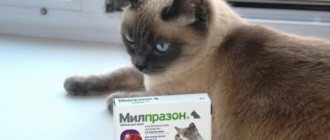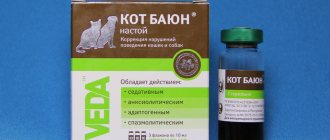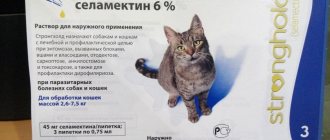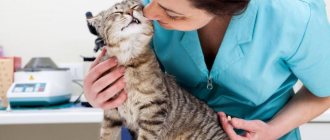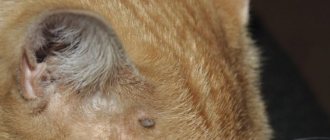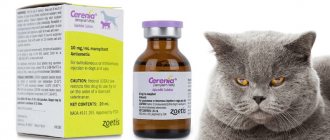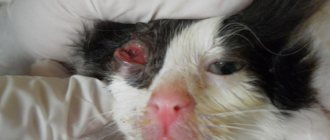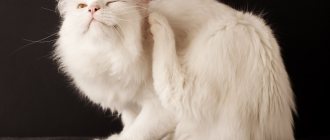Feliferon for cats is used as an immunomodulatory and antiviral drug for the treatment of gastrointestinal and respiratory diseases, chlamydia and mycoplasmosis. It became the first Russian immunomodulator to use recombinant copies of feline omega interferon.
This made it possible to increase the effectiveness of animal treatment by stimulating the body’s own defense mechanisms.
COMPOUND
Active substance:
- Feliferon for cats, according to the instructions, 1 ml contains feline interferon with antiviral activity of 400,000 IU as an active ingredient
Excipients:
- dextran-40 50.00 mg
- sodium salt of ethylenediaminetetraacetic acid 0.07 mg
- sodium acetate 1.64 mg
- sodium chloride 5.84 mg
- polysorbate-20 0.10 mg
- glacial acetic acid about 0.0045 ml
- water for injection up to 1 ml
PHARMACOLOGICAL PROPERTIES OF FELIFERON
Pharmacological group: immunomodulators, drugs with antiviral activity. Feliferon for cats has an immunostimulating and antiviral effect.
The mechanism of action consists of:
- increased phagocytic activity of macrophages in cats
- increasing the specific cytotoxicity of lymphocytes
- increasing the resistance of healthy cells of the cat’s body to infection with viruses
- in suppressing the reproduction of RNA and DNA viruses in infected cells
According to the degree of impact on the cat’s body, Feliferon is classified as a low-hazard substance
(grade 4), in recommended doses does not have a skin irritant or resorptive toxic effect.
Operating principle
Despite the fact that interferon does not have a direct damaging effect on the virus, it provokes in the cat’s tissue cells the production of substances that prevent the reproduction and development of pathogenic microorganisms by blocking their protein synthesis.
The immunostimulating mechanism of Feliferon is to accelerate the production of macrophages that capture and subsequently remove microbes from the body. They also increase the synthesis of T-lymphocytes, which dissolve destroyed cells of affected tissues.
This double effect makes it possible to notice an improvement in the condition of the sick animal after the first administration of the drug. In most cases, pulmonary and heart rhythms normalize in cats, the temperature decreases, and recovery occurs faster.
Immediately after the administration of Feliferon, the animal may experience a sharp temperature jump, leading to the “burning out” of viruses. This is a natural reaction of the body to the action of interferon, so this symptom is not a complication or side effect.
Why use Feliferon to treat cats?
According to the instructions, feliferon is designed for the treatment of viral diseases of cats. Field studies of cats with calicivirus infection have shown a reduction in the severity and duration of clinical signs associated with the virus. The drug has also been used in the adjunctive therapy of cats with infectious peritonitis with uncertain clinical results.
Feliferon for cats has been used experimentally in the treatment of feline viral infections, including leukemia, immunodeficiency and coronavirus infection.
Feline interferon given prophylactically or therapeutically to cats experimentally infected with FIP does not reduce mortality. However, the high-dose protocol resulted in transient suppression of clinical signs and decreased serum antibody titers to FIP with increased survival time (weeks) compared to untreated cats. There are no good studies on the effect of this treatment on spontaneously occurring FIP infection, although one protocol has been described using human interferon alpha 30 IU/day orally for 7 days on alternating weeks for 6–7 weeks.
Feliferon in cats is indicated for the treatment of herpes keratitis.
Trials are currently underway to examine the potential benefits of interferon therapy for feline chronic gingivostomatitis.
Advantages
- Immunostimulating effect. Its essence is the activation of leukocytes, which are responsible for eliminating viral infections.
- Antiviral effect. Protein synthesis in affected cells slows down.
- Feline interferon is specifically designed for these animals, which contributes to more effective treatment and the formation of positive dynamics.
- The animal does not get used to the medicine.
- There are no side effects associated with the toxicity of the product.
- There are no restrictions on the age of the animal. Feliferon can be used for kittens from the first days of life.
INDICATIONS
Feliferon is prescribed to cats according to the instructions for use for therapeutic and prophylactic purposes for:
- feline herpesvirus (rhinotracheitis)
- panleukopenia
- calicivirus
- anemia and hypovitaminosis
- in the postoperative period
- in the postpartum period
- secondary immunodeficiency
- gastrointestinal
- invasive diseases
- acute respiratory
- poisoning
- other diseases of viral or mixed etiology
MODE OF APPLICATION
Feliferon solution for injection is administered intramuscularly to cats. If there is a threat of infection, the drug is prescribed at a dose of 200,000 IU per animal, twice with an interval of 48 hours. For the treatment of cats with viral, bacterial and mixed diseases, Feliferon is administered in a daily dose of 200,000 IU, for 5-7 days in combination with antibiotics, serum and immunoglobulin preparations, in accordance with the instructions for their use.
In severe cases of the disease and mixed infections, it is recommended to increase the average therapeutic dose by 2 times - 400,000 IU.
No overdose symptoms have been identified when using the drug. Avoid missing the next dose of Feliferon in cats, as this may lead to a decrease in therapeutic effectiveness. If one dose is missed, it is necessary to administer it to the cat as soon as possible, then the interval between administrations of the drug does not change.
Immunomodulatory and antiviral drug Feliferon 2.5 ml No. 1 for injection
Attention! The product is only available for pickup due to special storage conditions!
The price is for one bottle.
COMPOSITION AND RELEASE FORM Feliferon, injection solution in 1 ml contains cat interferon with antiviral activity of 400,000 IU as an active ingredient, excipients: glacial acetic acid about 0.0045 ml (until the pH is established from 4.5 to 5.0) , 1.64 mg sodium acetate, 5.84 mg sodium chloride, 0.10 mg polysorbate-20, 0.07 mg sodium salt of ethylenediaminetetraacetic acid, 50.00 mg dextran 40 and water for injection up to 1 ml. In appearance, the drug is a colorless, transparent or slightly opalescent liquid. Feliferon solution for injection is produced packaged in 2.5 ml glass bottles, sealed with rubber stoppers and reinforced with aluminum caps. The drug is packaged in 2 or 5 bottles in cardboard boxes with instructions for use.
PHARMACOLOGICAL PROPERTIES Pharmacological group: immunomodulators. Feliferon has antiviral and immunostimulating effects. The mechanism of action is to suppress the reproduction of DNA and RNA viruses in infected cells, increase the resistance of healthy cells of the body to infection by viruses, enhance the phagocytic activity of macrophages and increase the specific cytotoxicity of lymphocytes. In terms of the degree of impact on the body, it is classified as a low-hazard substance (hazard class 4 according to GOST 12.1.007-76); in recommended doses it does not have a skin-irritant or resorptive-toxic effect.
INDICATIONS Prescribed for therapeutic and prophylactic purposes to cats with gastrointestinal, acute respiratory and other diseases of viral or mixed etiology, as well as anemia and hypovitaminosis, invasive diseases, poisoning, in the postpartum and postoperative periods and secondary immunodeficiency.
DOSES AND METHOD OF APPLICATION Feliferon solution for injection is administered intramuscularly. If there is a threat of infection for prophylactic purposes, the drug is prescribed at a dose of 200,000 IU per animal, twice with an interval of 48 hours. For the treatment of viral, bacterial and mixed diseases of cats, the drug is administered in a daily dose of 200,000 IU, for 5-7 days in combination with antibiotics, serum and immunoglobulin preparations, in accordance with the instructions for their use. In severe cases of the disease and mixed infections, it is recommended to increase the average therapeutic dose by 2 times - 400,000 IU. No overdose symptoms have been identified when using the drug. Avoid skipping the next dose of the drug, as this may lead to a decrease in therapeutic effectiveness. If one dose is missed, it is necessary to administer it as soon as possible; then the interval between administrations of the drug does not change.
SIDE EFFECTS There are no side effects or complications when using the drug in accordance with these instructions. In case of increased individual sensitivity and the occurrence of allergic reactions, the drug should be discontinued and the animal should be prescribed antihistamines and symptomatic therapy.
CONTRAINDICATIONS Individual hypersensitivity of the animal to interferons (including history), severe allergic and autoimmune diseases. It is not recommended to use the drug Feliferon solution for injection after vaccination of animals for 10 days.
SPECIAL INSTRUCTIONS The specific effects of the drug upon first use or upon withdrawal have not been established. Feliferon injection solution should not be mixed in the same syringe with other medications. Combined use with any chemotherapeutic and immunobiological agents (serum and immunoglobulin) is allowed. Not intended for use in food producing animals. Preventive measures: When working with Feliferon, you should follow the general rules of personal hygiene and safety precautions provided for when working with medications. In case of accidental contact of the drug with the skin or mucous membranes of the eyes, they must be rinsed with plenty of running water. People with hypersensitivity to the components of the drug should avoid direct contact with the drug. If allergic reactions occur or if the drug accidentally enters the human body, you should immediately contact a medical facility (bring with you the instructions for use of the drug or the label). Empty drug bottles must not be used for household purposes; they must be disposed of with household waste.
STORAGE CONDITIONS In sealed manufacturer's packaging, in a dry place, protected from direct sunlight, out of reach of children and animals, separately from food and feed at a temperature of 2 °C to 8 °C. The shelf life of the medicinal product, subject to storage conditions in a closed package, is 24 months from the date of manufacture, after opening the bottle - no more than 5 days. After the expiration date, the injection solution should not be used.
Prevention measures:
If allergic reactions occur or if the drug accidentally enters the human body, you should immediately contact a medical facility (bring the instructions or label with you).
People with hypersensitivity to the components of the drug should avoid direct contact with the drug. When working with Feliferon for cats, you should follow the general rules of personal hygiene and safety precautions provided for when working with medications.
If a person accidentally comes into contact with the medicinal product with the skin or mucous membranes of the eyes, they must be rinsed with plenty of running water.
Empty drug bottles must not be used for household purposes; they must be disposed of with household waste.
Analogues of the product
It is not always possible to find a specific medicine, or it may not be suitable due to the dosage form. There are different analogues of Feliferon for cats. Neoferon is available in tablet form; it contains a complex of 13 plants that stimulate the immune system and cause its increase. Inulin is a prebiotic and allows you to restore intestinal microflora, which improves the body's resistance.
Nephoren is prescribed as a supportive agent for various diseases, accelerating recovery after operations. It has an antiseptic, immunomodulatory effect. In case of damage to soft tissues, the drug prevents the appearance of purulent wounds.
Tablets are easier to give to a cat. The product is mixed with food or injected into the mouth using a special device. The average course of treatment is 10 days. The drug has no side effects; in rare cases, individual intolerance to the components occurs.
Another effective immunomodulator is Immunofan . For cats, only the injectable form is used. It has a wide spectrum of action, it is effective for restoring and increasing the level of immunity, recovery after operations and injuries, and eliminates inflammatory processes. The advantage of Immunofan is the improvement of liver function.
Fosprenil is also an immunomodulator and is available in the form of an injection solution. Effective against a number of viral diseases - calcivirus, rhinotracheitis, herpesvirus and others. It is used to relieve gastrointestinal pathologies and peritonitis. Suppresses the development of pathogenic flora and promotes recovery.
Fosprenil can be taken by drinking water rather than given as injections. The average dose is calculated based on 0.5 ml per 1 kg of animal. Minor side effects may occur (drowsiness, apathy, lethargy, and so on).
Learn about essential antimicrobials in animals
- Trichopolum instructions for veterinary medicine
- Instructions for the use of the antibiotic Baytril in animals
- Instructions for use of metronide
- Instructions for ceftriaxone preparations for animals
- Use of Metrogyl in veterinary medicine
- Instructions for doxycycline in animals
- Metronidazole (Metronidazole) for animals (instructions for use in veterinary medicine, doses, indications and contraindications)
- Atovaquone (ATOVAQUONE)
- Azithromycin, instructions for animal therapy
^Top
Consumer Reviews
I have always been skeptical of domestic manufacturers. Cheap could not be high quality. Therefore, I was surprised when the veterinarian prescribed a course of Feliferon to restore the cat after giving birth. After the injections, she became interested in kittens, leaving the house and eating.
Anastasia
While relaxing at the dacha, the cat contracted an infectious disease. He was constantly vomiting and had diarrhea. I had to urgently return to the city and go to the vet. The doctor made a disappointing diagnosis and prescribed treatment. I believe that it was Feliferon that helped the animal recover.
Andrey
The cat suddenly caught a cold.
She didn't react to anything. The veterinarian prescribed treatment. Among the drugs was Feliferon. I was skeptical about the prescription, but completed the course. On the second day, the pet came to life and began to behave actively. He asked me to eat, drank water and responded to me. Elena

